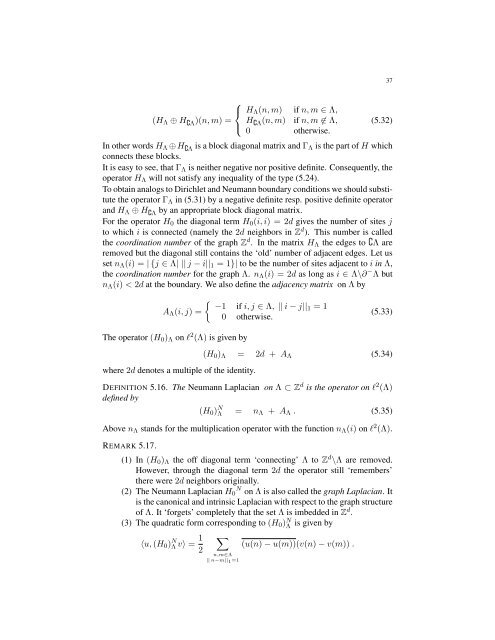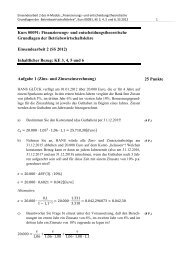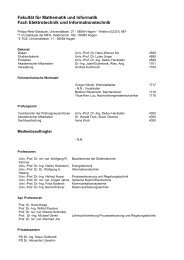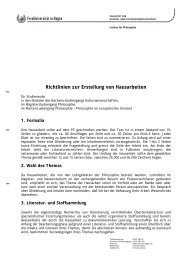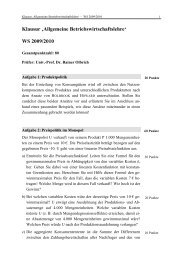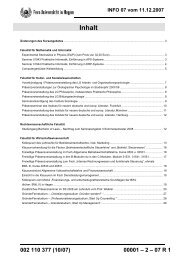An Invitation to Random Schr¨odinger operators - FernUniversität in ...
An Invitation to Random Schr¨odinger operators - FernUniversität in ...
An Invitation to Random Schr¨odinger operators - FernUniversität in ...
You also want an ePaper? Increase the reach of your titles
YUMPU automatically turns print PDFs into web optimized ePapers that Google loves.
37<br />
⎧<br />
⎨ H Λ (n, m) if n, m ∈ Λ,<br />
(H Λ ⊕ H ∁Λ )(n, m) = H<br />
⎩ ∁Λ (n, m) if n, m ∉ Λ,<br />
0 otherwise.<br />
(5.32)<br />
In other words H Λ ⊕ H ∁Λ is a block diagonal matrix and Γ Λ is the part of H which<br />
connects these blocks.<br />
It is easy <strong>to</strong> see, that Γ Λ is neither negative nor positive def<strong>in</strong>ite. Consequently, the<br />
opera<strong>to</strong>r H Λ will not satisfy any <strong>in</strong>equality of the type (5.24).<br />
To obta<strong>in</strong> analogs <strong>to</strong> Dirichlet and Neumann boundary conditions we should substitute<br />
the opera<strong>to</strong>r Γ Λ <strong>in</strong> (5.31) by a negative def<strong>in</strong>ite resp. positive def<strong>in</strong>ite opera<strong>to</strong>r<br />
and H Λ ⊕ H ∁Λ by an appropriate block diagonal matrix.<br />
For the opera<strong>to</strong>r H 0 the diagonal term H 0 (i, i) = 2d gives the number of sites j<br />
<strong>to</strong> which i is connected (namely the 2d neighbors <strong>in</strong> Z d ). This number is called<br />
the coord<strong>in</strong>ation number of the graph Z d . In the matrix H Λ the edges <strong>to</strong> ∁Λ are<br />
removed but the diagonal still conta<strong>in</strong>s the ‘old’ number of adjacent edges. Let us<br />
set n Λ (i) = | {j ∈ Λ| || j − i|| 1 = 1}| <strong>to</strong> be the number of sites adjacent <strong>to</strong> i <strong>in</strong> Λ,<br />
the coord<strong>in</strong>ation number for the graph Λ. n Λ (i) = 2d as long as i ∈ Λ\∂ − Λ but<br />
n Λ (i) < 2d at the boundary. We also def<strong>in</strong>e the adjacency matrix on Λ by<br />
{<br />
−1 if i, j ∈ Λ, || i − j||1 = 1<br />
A Λ (i, j) =<br />
0 otherwise.<br />
(5.33)<br />
The opera<strong>to</strong>r (H 0 ) Λ on l 2 (Λ) is given by<br />
where 2d denotes a multiple of the identity.<br />
(H 0 ) Λ = 2d + A Λ (5.34)<br />
DEFINITION 5.16. The Neumann Laplacian on Λ ⊂ Z d is the opera<strong>to</strong>r on l 2 (Λ)<br />
def<strong>in</strong>ed by<br />
(H 0 ) N Λ = n Λ + A Λ . (5.35)<br />
Above n Λ stands for the multiplication opera<strong>to</strong>r with the function n Λ (i) on l 2 (Λ).<br />
REMARK 5.17.<br />
(1) In (H 0 ) Λ the off diagonal term ‘connect<strong>in</strong>g’ Λ <strong>to</strong> Z d \Λ are removed.<br />
However, through the diagonal term 2d the opera<strong>to</strong>r still ‘remembers’<br />
there were 2d neighbors orig<strong>in</strong>ally.<br />
(2) The Neumann Laplacian H N 0 on Λ is also called the graph Laplacian. It<br />
is the canonical and <strong>in</strong>tr<strong>in</strong>sic Laplacian with respect <strong>to</strong> the graph structure<br />
of Λ. It ‘forgets’ completely that the set Λ is imbedded <strong>in</strong> Z d .<br />
(3) The quadratic form correspond<strong>in</strong>g <strong>to</strong> (H 0 ) N Λ<br />
is given by<br />
〈u, (H 0 ) N Λ v〉 = 1 ∑<br />
(u(n) − u(m))(v(n) − v(m)) .<br />
2<br />
n,m∈Λ<br />
|| n−m|| 1 =1


